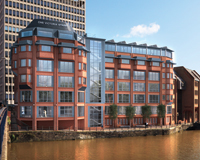When 2012 dawned on Bristol there was a sense that this was not just to be a diamond, jubilant, Olympic year; it was to be one in which the city centre’s office development market finally ground back into action after an extended hibernation.
Given the go-ahead in 2008, HDG Mansur’s 113,000 sq ft Bridgewater House at Finzel’s Reach was the last significant speculative office development. In the four years since, total supply of grade-A space either available or under construction has dwindled from around 650,000 sq ft in September 2008 to around 340,000 sq ft today, with nothing under construction.
With new – and significantly large – enquiries circling the market at the beginning of the year, coupled with the relative shortage of grade-A space capable of satisfying a 40,000 sq ft requirement, might developers finally be prompted to start one of the many mooted schemes?
Requirements from Canada Life for 30,000 sq ft, Allianz for 45,000 sq ft, Mapfre for 45,000 sq ft and Veale Wasbrough for 40,000 sq ft were among those being openly discussed, with others rumoured to be in the market.
Such sizeable grade-A requirements are crucial to development in Bristol as just two buildings – Bridgewater House, which eventually completed to shell and core in March 2011, and UK & European Investments’ 125,000 sq ft Templeback – can accommodate anything that large.
But, as with this year’s spring weather, the early promise quickly faded and many of the supposedly hot enquiries cooled. Mapfre is now tipped for secondhand space and Allianz appears to have stalled, while Veal Wasborough is under offer for space in Standard Life’s refurbishment of Narrow Quay House.
By the end of June, the H1 figures recorded just two grade-A deals, totalling a paltry 16,327 sq ft, split evenly between Ernst & Young at The Paragon and Towry at Portwall Place. Then the summer slowdown really set in.
CBRE senior director Philip Morton says: “Pre-Jubilee, I would have said that there would be at least one deal of 45,000 sq ft, but as the year has gone on it’s becoming less likely that we’ll get a decent letting. There isn’t anyone in the market that is looking for major grade-A space – they’ve pulled their requirements back to smaller or secondhand.”
So, despite a widely held view that just a couple of significant grade-A lettings could prompt a speculative start, no one has triggered this yet.
In the words of Jeremy Richards, head of Jones Lang LaSalle’s Bristol office: “Chances of any new speculative development starting this year: none.”
Regardless of this, many agents in the area remain confident the market dynamics are such that at least one scheme will get off the ground soon. Alder King partner Simon Price maintains the shortage of space is “leading a couple of developers to consider whether they should go ahead with speculative starts”, and clearly whoever finishes first could be in a strong position.
With funding for speculative development near impossible, chief among the waiting pack is Salmon Harvester’s 2 Glass Wharf. The 100,000 sq ft development is widely tipped as the frontrunner to capitalise on the shortage of grade-A space, should deals emerge not just because of the financial backing of NFU Mutual, but because the existing basement and concrete slab would give it a head start for a quick completion.
Salmon Harvester development director Rorie Henderson says the partnership has been “monitoring the market closely to judge the right time to commit”, but no decision has yet been made.
In the meantime, refurbishments seem to be showing the first signs of activity. Standard Life can start its refurbishment of Narrow Quay House now that Veal Wasborough has gone under offer there. But, more encouragingly for the market, PRUPIM has decided to go ahead speculatively with its refurbishment and extension of the 1980s One Victoria Street. PRUPIM was unavailable to comment. Work will start on the 47,000 sq ft scheme this month, with completion in autumn 2013.
So while the market may have been split on whether 2012 was a false dawn, there is at least some light emerging to give encouragement, and the knowledge that with an ever-diminishing supply of grade A, the sun will have to rise eventually.











